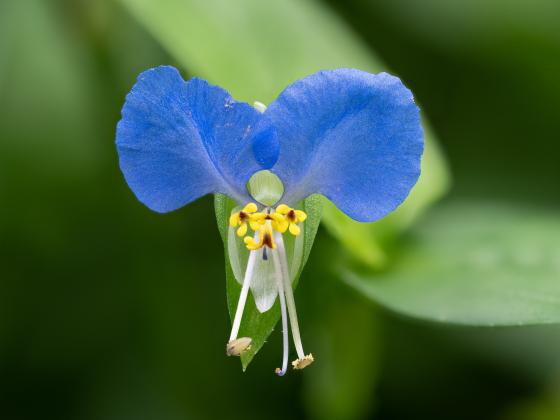Com mel ina communis
True blue, unlike the sky or blue jay's feather
Commelina communis, dayflower, is an annual seen in Grimes County from spring until frost. Its bright blue flowers, about an inch wide, last one day. They open in the morning and are gone by early afternoon. There are three petals, two blue on top and one smaller white one underneath. A bract at the flower’s base contains a mucilaginous sap which oozes out in a drop when squeezed. One of dayflower’s other names is widow’s tears.
Flowers emerge from nodes at the base of alternate leaves which are from 1 to 4 inches long and ½ to 1 ½ inches wide with parallel veins. There may be one line of fine hairs near the nodes. The stem can be up to 2 feet long but it may not seem so. It sprawls, turning erect near the top. It can form mats, blending unnoticed in the grass until the flowers bloom. Dayflowers can root from any of its multiple nodes which is why it will probably come back even when mowed. Some consider it invasive.
In many places dayflower is eaten as a vegetable. The flowers and young leaves are eaten raw in salads. Older leaves and stems are cooked. To find the tenderest part of the stem, do what is done to asparagus. Bend it until you find the place where it snaps. They taste similar to green beans. The small seeds taste like peas. It has a mucilaginous texture but not as much as okra.
Like many other mucilaginous plants, dayflower is used medicinally to treat skin issues such as burns, snake bites, etc. It is antibacterial, anti-inflammatory, antioxidant, used to treat diarrhea, sore throat, cough, fever, diabetes, etc. It is used as a wash for eye irritations. Following are some dayflower articles from the National Institutes of Health, pubmed.ncbi.nlm.nih.gov:
• “Antioxidant, Antibacterial, Antidiarrheal and Antipyretic Activities of Organic Crude Fractions of Commelina”
• “Anti-influenza-virus Activity of Total Alkaloids from Commelina Communis L”
• “Anti-hyperglycemic Activity of Commelina Communis L.: Inhibition of Alpha-Glucosidase”
The color blue is not common in nature. That’s why it isn’t found on walls of ancient cave paintings. Much of the blue we see such as the sky or a blue jay’s feather is not really blue. They have no blue pigment. Our eyes sense their light refraction as blue. (Yes, water has a bit of blue.) Dayflower has blue pigment and produces a bright blue dye. Petals are crushed and cloth or paper is dipped into the juice to absorb it. Once dried the dye can be stored. When needed, the paper or cloth is put into water to release the color. But it will eventually fade to yellow-green.
Dayflower is in the Commelinaceae family and like another family member, spiderwort, dayflower’s normally blue stamens turn pink when exposed to ionizing radiation or chemical pollution. Also, dayflower bioaccumulates metals especially copper. It is often planted around copper mines for phytoremediation, a technology that uses living plants to clean the environment.

